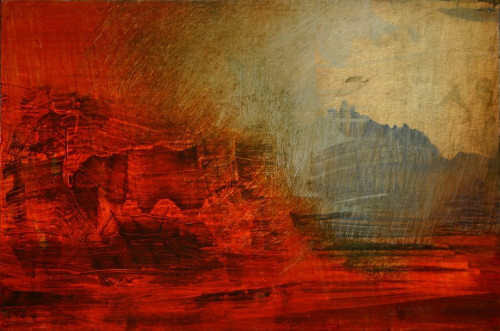River #16
Lavadour is tremendously impacted by certain scientific concepts such as the physics of flow- the way fluid is put in motion when acted upon by different unbalanced forces. To Lavadour, the way gravity interacts with the viscosity of the paint replicates the scientific principles that occur according to natural law- once again tying his painting to the processes of the earth at large. His painting philosophy also mirrors the Law of Conservation of Energy, meaning energy cannot be created or destroyed just transformed. Certainly then Lavadour’s use of paint- letting it become what it wants and never trying to alter those changes- displays a loyalty to these laws of nature and loyalty to his belief painting should mirror the earth. Therefore, it is not surprising that his paintings, such as River #16, look like earthly processes because he uses the same scientific principles as the earth in his painting.
River #16 from 2007 is a small painting rising barely over a foot in height and width, but its impact is that of a much larger work. It has two sections of contrasting colors: a deep red on the left and center of the canvas, a creamy blue-grey in the upper right corner, and the two sections swirl and clash at the top center of the canvas. On the left in the red is mountainous imagery (perhaps the Blue Mountains of his home) scraped on and incised in with black paint. It is highly detailed and reflective, with light catching the bright red and making it shine brilliantly. The red is dominant and almost seems to overtake the other grey-blue half of the canvas, but it fights and peaks through, even overtaking some of the top at the center where the blue-grey mist spreads over the red. In the right corner is a creamy sky with a big blue-grey mountain showing itself through the mist and the red.
The two sides collide and coexist, perhaps like nature and civilization or the different layers of time that nature holds in its various stratigraphic layers. One could also potentially see the two colors as the clashing of indigenous people and settlers of the land, where the red is the settlers that overtook the land and the blue mountain is the original inhabitants of the land asserting their existence. In the end, it is up to the viewer to make an informed decision on how to think and feel about the painting so long as- as Lavadour would want- one spends time looking at the painting and visually taking it in before deciding an interpretation based on what we know about Lavadour. Personal experience with the painting is vital with Lavadour’s work. Even if one is only looking online, it still requires the viewer to spend time with it to understand how it speaks to us about nature, time, and our relationship to such forces.

